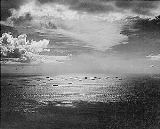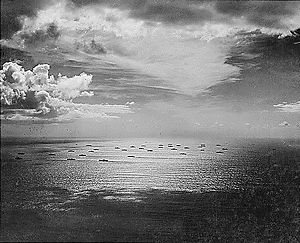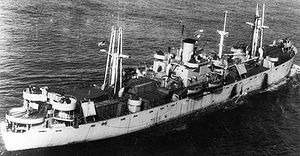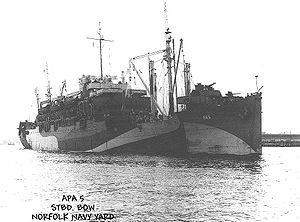
UG convoys
Encyclopedia
The UG convoys were a series of east-bound trans-Atlantic
convoy
s from the United States
to Gibraltar
carrying food, ammunition, and military hardware to the United States Army
in North Africa
and southern Europe
during World War II
. These convoys assembled in Hampton Roads
near the mouth of Chesapeake Bay
and terminated in various North African locations as Axis
forces retreated from 1942 through 1945.


to the British Isles
in HX convoys
since 1939 and in slower SC convoys
since 1940. These convoys were escorted by the Royal Navy
and Royal Canadian Navy
. The United States Navy
provided a few escorts to HX and SC convoys from September of 1941 through April of 1943. UG convoys were established as a second, more direct, supply route to support the invasion of North Africa
. The first convoy, designated UGF 1, was the invasion convoy sailing on 24 October 1942 and arriving on 8 November 1942. The F designated a convoy of faster ships. Thereafter, fast and slow eastbound and westbound convoys on this southern route were given four separate numbering sequences beginning with 2.
 Approximately one fast eastbound convoy per month departed Hampton Roads along the southern trans-Atlantic route beginning with convoy UGF 2 on 2 November 1942. Convoys UGF 2 and UGF 3 terminated in Casablanca
Approximately one fast eastbound convoy per month departed Hampton Roads along the southern trans-Atlantic route beginning with convoy UGF 2 on 2 November 1942. Convoys UGF 2 and UGF 3 terminated in Casablanca
in 1942. Convoys UGF 4 through UGF 10 terminated in Oran
in 1943. Convoys UGF 8 and UGF 9 sailed in two sections with the second section being identified as UGF 8A and UGF 9A, respectively. Fast convoys were temporarily suspended during preparation for Operation Overlord
after convoy UGF 10 reached Oran on 2 September 1943. Sailings resumed on 17 May 1944, and convoys UGF 11 through UGF 21 terminated in Naples
in 1944 and 1945. Separate convoys designated UGF 15B and UGF 17B terminated in Marseilles. The last fast eastbound convoy UGF 22 terminated in Oran on 8 April 1945. A total of 382 ships sailed in 26 fast convoys, and none were lost.
.jpg) Approximately two slow eastbound convoys per month departed Hampton Roads along the southern trans-Atlantic route beginning with convoy UGS 2 on 13 November 1942. Frequency of sailing increased to three convoys per month in the summer of 1943 and increased again to six convoys per month in 1945. The last slow eastbound convoy, UGS 95, left Hampton Roads on 28 May 1945. Approximately 5800 ships sailed in 100 slow convoys. Additional sections were identified as UGS 5A, UGS 6A, UGS 7A, UGS 8A, UGS 33A, and UGS 55B.
Approximately two slow eastbound convoys per month departed Hampton Roads along the southern trans-Atlantic route beginning with convoy UGS 2 on 13 November 1942. Frequency of sailing increased to three convoys per month in the summer of 1943 and increased again to six convoys per month in 1945. The last slow eastbound convoy, UGS 95, left Hampton Roads on 28 May 1945. Approximately 5800 ships sailed in 100 slow convoys. Additional sections were identified as UGS 5A, UGS 6A, UGS 7A, UGS 8A, UGS 33A, and UGS 55B.
Convoy UGS 6 came under attack by wolf packs Unverzagt, Wohlgemut, and Tummler during the submarine offensive including the battle of convoys HX 229/SC 122. Three ships were sunk:
These were the only ships lost during the Atlantic crossing of these convoys, although the following ships were lost in the Mediterranean Sea
:
s providing anti-submarine screens for these convoys had United States Coast Guard
crews. Most of these convoys were given air coverage from escort carriers and patrol bombers flying from the Azores
. The Royal Navy initially provided escorts within the Mediterranean, although United States escorted these convoys as far as Oran as the front moved east.
Atlantic Ocean
The Atlantic Ocean is the second-largest of the world's oceanic divisions. With a total area of about , it covers approximately 20% of the Earth's surface and about 26% of its water surface area...
convoy
Convoy
A convoy is a group of vehicles, typically motor vehicles or ships, traveling together for mutual support and protection. Often, a convoy is organized with armed defensive support, though it may also be used in a non-military sense, for example when driving through remote areas.-Age of Sail:Naval...
s from the United States
United States
The United States of America is a federal constitutional republic comprising fifty states and a federal district...
to Gibraltar
Gibraltar
Gibraltar is a British overseas territory located on the southern end of the Iberian Peninsula at the entrance of the Mediterranean. A peninsula with an area of , it has a northern border with Andalusia, Spain. The Rock of Gibraltar is the major landmark of the region...
carrying food, ammunition, and military hardware to the United States Army
United States Army
The United States Army is the main branch of the United States Armed Forces responsible for land-based military operations. It is the largest and oldest established branch of the U.S. military, and is one of seven U.S. uniformed services...
in North Africa
Africa
Africa is the world's second largest and second most populous continent, after Asia. At about 30.2 million km² including adjacent islands, it covers 6% of the Earth's total surface area and 20.4% of the total land area...
and southern Europe
Europe
Europe is, by convention, one of the world's seven continents. Comprising the westernmost peninsula of Eurasia, Europe is generally 'divided' from Asia to its east by the watershed divides of the Ural and Caucasus Mountains, the Ural River, the Caspian and Black Seas, and the waterways connecting...
during World War II
World War II
World War II, or the Second World War , was a global conflict lasting from 1939 to 1945, involving most of the world's nations—including all of the great powers—eventually forming two opposing military alliances: the Allies and the Axis...
. These convoys assembled in Hampton Roads
Hampton Roads
Hampton Roads is the name for both a body of water and the Norfolk–Virginia Beach metropolitan area which surrounds it in southeastern Virginia, United States...
near the mouth of Chesapeake Bay
Chesapeake Bay
The Chesapeake Bay is the largest estuary in the United States. It lies off the Atlantic Ocean, surrounded by Maryland and Virginia. The Chesapeake Bay's drainage basin covers in the District of Columbia and parts of six states: New York, Pennsylvania, Delaware, Maryland, Virginia, and West...
and terminated in various North African locations as Axis
Axis Powers
The Axis powers , also known as the Axis alliance, Axis nations, Axis countries, or just the Axis, was an alignment of great powers during the mid-20th century that fought World War II against the Allies. It began in 1936 with treaties of friendship between Germany and Italy and between Germany and...
forces retreated from 1942 through 1945.


Background
Allied war materials had been transported from North AmericaNorth America
North America is a continent wholly within the Northern Hemisphere and almost wholly within the Western Hemisphere. It is also considered a northern subcontinent of the Americas...
to the British Isles
British Isles
The British Isles are a group of islands off the northwest coast of continental Europe that include the islands of Great Britain and Ireland and over six thousand smaller isles. There are two sovereign states located on the islands: the United Kingdom of Great Britain and Northern Ireland and...
in HX convoys
HX convoys
The HX convoys were a series of North Atlantic convoys which ran during the Battle of the Atlantic in World War II. They were east-bound convoys and originated in Halifax, Nova Scotia from where they sailed to ports in the United Kingdom...
since 1939 and in slower SC convoys
SC convoys
The SC convoys were a series of North Atlantic convoys that ran during the battle of the Atlantic during World War II.They were east-bound slow convoys originating in Sydney, Cape Breton ; from there they sailed to ports in the UK, mainly Liverpool.For a time after the entry of the...
since 1940. These convoys were escorted by the Royal Navy
Royal Navy
The Royal Navy is the naval warfare service branch of the British Armed Forces. Founded in the 16th century, it is the oldest service branch and is known as the Senior Service...
and Royal Canadian Navy
Royal Canadian Navy
The history of the Royal Canadian Navy goes back to 1910, when the naval force was created as the Naval Service of Canada and renamed a year later by King George V. The Royal Canadian Navy is one of the three environmental commands of the Canadian Forces...
. The United States Navy
United States Navy
The United States Navy is the naval warfare service branch of the United States Armed Forces and one of the seven uniformed services of the United States. The U.S. Navy is the largest in the world; its battle fleet tonnage is greater than that of the next 13 largest navies combined. The U.S...
provided a few escorts to HX and SC convoys from September of 1941 through April of 1943. UG convoys were established as a second, more direct, supply route to support the invasion of North Africa
Operation Torch
Operation Torch was the British-American invasion of French North Africa in World War II during the North African Campaign, started on 8 November 1942....
. The first convoy, designated UGF 1, was the invasion convoy sailing on 24 October 1942 and arriving on 8 November 1942. The F designated a convoy of faster ships. Thereafter, fast and slow eastbound and westbound convoys on this southern route were given four separate numbering sequences beginning with 2.
Fast eastbound convoys designated UGF

Casablanca
Casablanca is a city in western Morocco, located on the Atlantic Ocean. It is the capital of the Grand Casablanca region.Casablanca is Morocco's largest city as well as its chief port. It is also the biggest city in the Maghreb. The 2004 census recorded a population of 2,949,805 in the prefecture...
in 1942. Convoys UGF 4 through UGF 10 terminated in Oran
Oran
Oran is a major city on the northwestern Mediterranean coast of Algeria, and the second largest city of the country.It is the capital of the Oran Province . The city has a population of 759,645 , while the metropolitan area has a population of approximately 1,500,000, making it the second largest...
in 1943. Convoys UGF 8 and UGF 9 sailed in two sections with the second section being identified as UGF 8A and UGF 9A, respectively. Fast convoys were temporarily suspended during preparation for Operation Overlord
Operation Overlord
Operation Overlord was the code name for the Battle of Normandy, the operation that launched the invasion of German-occupied western Europe during World War II by Allied forces. The operation commenced on 6 June 1944 with the Normandy landings...
after convoy UGF 10 reached Oran on 2 September 1943. Sailings resumed on 17 May 1944, and convoys UGF 11 through UGF 21 terminated in Naples
Naples
Naples is a city in Southern Italy, situated on the country's west coast by the Gulf of Naples. Lying between two notable volcanic regions, Mount Vesuvius and the Phlegraean Fields, it is the capital of the region of Campania and of the province of Naples...
in 1944 and 1945. Separate convoys designated UGF 15B and UGF 17B terminated in Marseilles. The last fast eastbound convoy UGF 22 terminated in Oran on 8 April 1945. A total of 382 ships sailed in 26 fast convoys, and none were lost.
Slow eastbound convoys designated UGS
.jpg)
Convoy UGS 6 came under attack by wolf packs Unverzagt, Wohlgemut, and Tummler during the submarine offensive including the battle of convoys HX 229/SC 122. Three ships were sunk:
- U-524 torpedoed the French freighter Wyoming on 15 March 1943.
- U-172 torpedoed the Liberty ShipLiberty shipLiberty ships were cargo ships built in the United States during World War II. Though British in conception, they were adapted by the U.S. as they were cheap and quick to build, and came to symbolize U.S. wartime industrial output. Based on vessels ordered by Britain to replace ships torpedoed by...
Benjamin HarrisonSS Benjamin HarrisonThe SS Benjamin Harrison was a Liberty ship built in the United States during World War II. She was named after Benjamin Harrison, the twenty-third President of the United States....
on 16 March 1943. - U-167 and U-521 torpedoed the Liberty Ship Molly Pitcher on 17 March 1943.
These were the only ships lost during the Atlantic crossing of these convoys, although the following ships were lost in the Mediterranean Sea
Mediterranean Sea
The Mediterranean Sea is a sea connected to the Atlantic Ocean surrounded by the Mediterranean region and almost completely enclosed by land: on the north by Anatolia and Europe, on the south by North Africa, and on the east by the Levant...
:
- U-73 torpedoed Liberty Ship Arthur Middleton in convoy UGS 3 on 1 January 1943.
- U-565 torpedoed the American freighter Michigan and the French troopship Sidi-bel-Abbes in convoy UGS 7 on 20 April 1943.
- U-572 torpedoed the French tanker Lot in convoy UGS 10 on 22 June 1943.
- British freighter Empire Kestrel in convoy UGS 13 was sunk by aircraft on 16 August 1943.
- U-410German submarine U-410German submarine U-410 was a Type VIIC U-boat built for the German Kriegsmarine for service during World War II operating mainly in the Mediterranean. Her Insignia was a Sword & Shield...
torpedoed Liberty Ships John Bell and Richard Henderson in convoy UGS 14 on 26 August 1943. - U-410 torpedoed Liberty Ship Christian Michelson in convoy UGS 17 on 26 September 1943.
- British freighter Fort Fitzgerald in convoy UGS 18 was sunk by aircraft on 4 October 1943.
- Liberty Ship Edward Bates in convoy UGS 30 was sunk by aircraft on 1 February 1944.
- Liberty Ships Virginia Dare and Daniel Chester French were sunk when convoy UGS 33 entered an Allied minefield on 6 March 1944.
- U-407 torpedoed Liberty Ships Meyer London and Thomas G. Masaryk in convoy UGS 37 on 16 April 1944.
- Liberty Ship Paul HamiltonSS Paul HamiltonThe SS Paul Hamilton was a Liberty ship built in the United States during World War II. She was named after Paul Hamilton, the third United States Secretary of the Navy....
and British freighter Royal Star in convoy UGS 38 were sunk by aircraft on 20 April 1944. - U-300 torpedoed British tanker Regent Lion in convoy UGS 72 on 17 February 1945.
Fast westbound convoys designated GUF
A total of 335 ships returned to the United States along the southern trans-Atlantic route in 24 fast convoys beginning with the sailing of convoy GUF 2 from Casablanca on 29 November 1942. The last fast westbound convoy GUF 22 left Oran on 16 April 1945. Additional sections were identified as GUF 2A, GUF 15B, and GUF 17B. No ships were lost from these fast convoys.Slow westbound convoys designated GUS
Approximately 5200 ships returned to the United States along the southern trans-Atlantic route in 98 slow convoys beginning with the sailing of convoy GUS 2 from Oran on 21 December 1942. The last slow westbound convoy GUS 92 left Oran on 27 May 1945. Additional sections were identified as GUS 5A, GUS 5B, GUS 6A, GUS 7A, GUS 8A, GUS 10X, and GUS 55B. There were no losses from these convoys during the Atlantic portion of their voyage, but five ships were lost within the Mediterranean Sea:- U-371 torpedoed the Liberty Ship James Russell Lowell in convoy GUS 18 on 15 October 1943.
- British freighter Alpherat in convoy GUS 25 was sunk by aircraft on 21 December 1943.
- U-969 torpedoed the Liberty Ships George Cleeve and Peter Skene Ogden in convoy GUS 31 on 22 February 1944.
- U-870 torpedoed the Liberty Ship Henry Miller in convoy GUS 63 on 3 January 1945.
Escorts
The United States Navy provided all escorts between Hampton Roads and Gibraltar, although some of the destroyer escortDestroyer escort
A destroyer escort is the classification for a smaller, lightly armed warship designed to be used to escort convoys of merchant marine ships, primarily of the United States Merchant Marine in World War II. It is employed primarily for anti-submarine warfare, but also provides some protection...
s providing anti-submarine screens for these convoys had United States Coast Guard
United States Coast Guard
The United States Coast Guard is a branch of the United States Armed Forces and one of the seven U.S. uniformed services. The Coast Guard is a maritime, military, multi-mission service unique among the military branches for having a maritime law enforcement mission and a federal regulatory agency...
crews. Most of these convoys were given air coverage from escort carriers and patrol bombers flying from the Azores
Azores
The Archipelago of the Azores is composed of nine volcanic islands situated in the middle of the North Atlantic Ocean, and is located about west from Lisbon and about east from the east coast of North America. The islands, and their economic exclusion zone, form the Autonomous Region of the...
. The Royal Navy initially provided escorts within the Mediterranean, although United States escorted these convoys as far as Oran as the front moved east.

